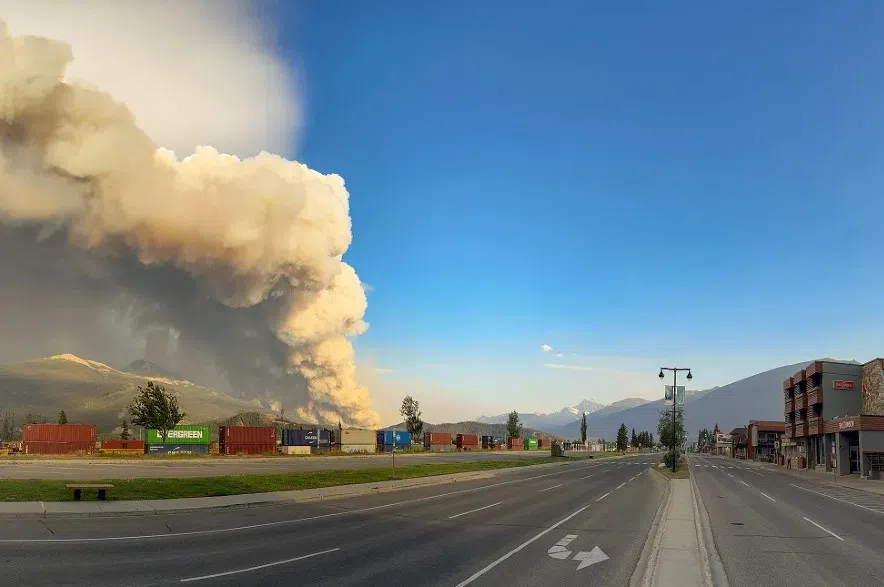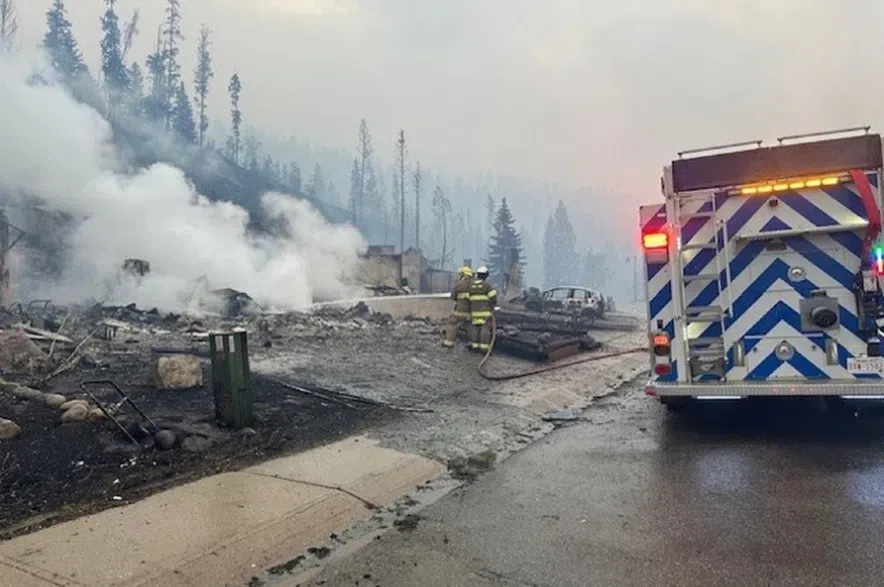JASPER, ALTA. — Alberta’s Jasper National Park and its townsite are under siege from two wind-whipped wildfires, one of which raced into the picturesque community on Wednesday night, causing extensive damage.
Parks Canada says the fire has caused significant losses within the town, and the social media account for Fairmont’s famous Jasper Park Lodge says the flames had reached the hotel’s grounds.
As the fire consumed more fuel, officials said the air quality dropped to dangerous levels, prompting fire crews without breathing apparatus to flee to the nearby community of Hinton.
Jasper has been badly damaged by wildfires, with charred remains of buildings and vehicles left behind.
(Video credit: @ryanjespersen) pic.twitter.com/vzZLQaa70Q
— 650 CKOM (@CKOMNews) July 25, 2024
Jasper, a postcard-perfect mountain town, is famous for hiking, skiing, kayaking and biking. It is also home to dozens of species such as elk, mountain goats, cougars, lynx, black bears and grizzly bears. The United Nations designated the parks that make up the Canadian Rockies, including Jasper, a World Heritage Site in 1984.
Photos on social media show lodges and other buildings wrapped in sheets of orange flame.
I am heartbroken to see reports that the wildfire has entered the townsite of Jasper.
The safety of everyone is our number one priority, and thankfully the town was evacuated earlier this week.
I want to thank all of our firefighters and crews who have been hard at work… pic.twitter.com/S5tcIapc9n
— Danielle Smith (@ABDanielleSmith) July 25, 2024
In an update shared to social media, Parks Canada said approximately 25,000 people were safely evacuated from the town of Jasper and Jasper National Park.
All residents, visitors and responders are safe.
The emergency evolved quickly from the first report of a wildfire northeast of Jasper Monday night just after 7 p.m. Another fire was spotted south of the town shortly after, and the wildfires reached the town within 48 hours.
Jasper National Park received some rain overnight, but it wasn’t enough to make a meaningful impact on the wildfire, which is still out of control.
Parks Canada, the Municipality of Jasper and its partners from Alberta and across Canada are working hard to respond to the emergency. Significant structural firefighting reinforcements arrived throughout the night and have been assisting with efforts in the community throughout the morning.
Parks Canada thanked its partners and everyone involved with fighting the blaze.
Due to the ongoing fire, the organization said it cannot yet report on the exact locations or the extent of damage. Parks Canada said it appreciates everyone’s patience and seeing the community and country of Canada come together to show support for the people of Jasper and the Parks Canada family.
Meanwhile, Prime Minister Justin Trudeau announced on social media that Ottawa has approved Alberta’s request for federal assistance. Alberta Forestry Minister Todd Loewen has asked for help from the Canadian military.
“We are requesting firefighting resources, aerial support to move wildfire crews and equipment and more,” Loewen wrote on the social media platform X.
Trudeau later shared a message of support for those working to battle the blaze.
“As the heartbreaking images from Jasper emerge, I want to thank the brave first responders who are in Alberta right now, fighting to save every home and every community they can,” the prime minister wrote.
“Thank you for your courage, and for working non-stop to fight these wildfires.”
I spoke with Premier @ABDanielleSmith yesterday evening about the wildfires in Alberta. We will use every tool at our disposal to support the province and protect communities. The safety of the public and of first responders is our top priority.
— Dominic LeBlanc (@DLeBlancNB) July 25, 2024
Earlier in the day, all first responders were ordered out of Jasper National Park for their safety and to give fire crews more room to operate.
The fires are burning on the north and south sides of the town, which is home to 5,000 people. The residents have left, along with 20,000 park visitors.
“It is one of the jewels of our national park system; one of the jewels of our entire country,” said 630 CHED Morning News Anchor Morgan Smith in Edmonton as she shared an update on the wildfire.
“The situation is not looking good in Jasper, to be quite frank.”
Smith said flames were hundreds of feet high in Jasper on Wednesday, and the fire was moving at 15 metres per second.
“Fire crews were basically powerless to stop that from happening,” Smith said.
Smith added that crews were focused on protecting critical infrastructure last night.
“Things like the water treatment plant, the hospital, the firehouse, and the Trans Mountain Pipeline, which goes from Edmonton all the way to B.C.”
The order to leave was issued around 10 p.m. Monday as fires cut off road access to Jasper. Residents and visitors fled west into British Columbia in a long, slow midnight procession through swirling smoke and ash.
The following day, evacuees in B.C. who didn’t have a place to stay were directed to make the long drive around the fires back to Alberta to evacuation centres in Grande Prairie and Calgary.
The northern fire was spotted five kilometres from Jasper earlier Wednesday. The southern fire was farther away, but Parks Canada says strong winds sent it racing toward the town.

Wildfire smoke is seen from the main street of the townsite in Jasper National Park on Wed., July 24, 2024. (Parks Canada/Facebook)
That forced crews using heavy equipment to pull back for safety. Water bombers were grounded due to dangerous flying conditions.
At the Grande Prairie evacuation centre, Addison McNeill recalled arriving in Jasper from Edmonton only to be told to get out.
“I moved there two hours before the evacuation notice,” the 24-year-old said in an interview.
McNeill said she went to a nearby hotel, one of two meet-up points for those without transportation. She hopped in a recreational vehicle with others and headed out — at a snail’s pace.
“Every single person in town was beelining to one exit from about six different routes and so you get bottleneck, backups and congestion,” she said.
McNeill said as she sat inside the vehicle, she felt so close to the wildfires that the windows seemed like they were going to shatter from the pressure of the hot, smoky air.
She saw acts of kindness amid the swirling ash: neighbours loaning their cars to those without; people knocking on doors to see if everyone inside was OK.
“It was far from a panic,” she said.
Richard Carr is a fire research analyst for the Northern Forestry Centre with the Canadian Forest Service.
He joined Evan Bray Show guest host Brent Loucks on Thursday morning to discuss wildfire trends contributing to Saskatchewan’s smoky skies and the devastation near Jasper.
He said the hot weather in recent weeks likely played a role in the Jasper fire.
“It’s a big shift in our weather from spring to July,” he said.
“June was probably dry in the Jasper area, but once we got into July we had these big up ridges that just sat over western Canada for days at a time. It’s been a very hot month. I think we were on track for maybe setting the hottest month on record in some locations in Alberta. I think the next few days may be a bit cooler, so it might reduce that chance. There’s been some extreme heat and dryness in the area.”
Carr said some work that takes place around towns in wooded areas to prevent fires from moving into them, but there are still challenges.
“A lot of these big fires, especially wind-driven fires, can really move quickly,” Carr explained.
“Embers can be thrown hundreds of metres, or even kilometres, so it’s tough to clear out enough field to completely protect a town.”
Carr said it’s hard to predict if intense forest fires and heavy smoke will be the new normal for summers in western Canada.
“We’re seeing more and more of these years where we see three to four million hectares burned, which is above our normal of probably two and a half million across Canada,” he said.
“Things are changing, but it’s tough to say exactly where it will end up. But we’ll probably see more frequent years with large-area burns.”
He said Canada has several agreements with other countries like the United States, Mexico, Australia and New Zealand to help with fighting forest fires if Canada runs out of resources.
–with files from 980 CJME’s Nicole Garn and Abby Zieverink











